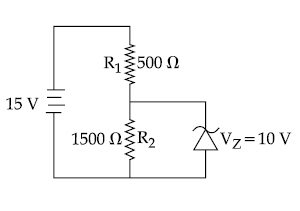
In the circuit diagram, the current through the Zener diode is:

A. 10mA
B. 3.33mA
C. 6.67mA
D. 0mA

Answer
490.8k+ views
- Hint: This question is based upon the basic property of Zener diode, as we know that it can operate continuously without being damaged in the region of reverse biased where it can act as voltage regulator and in forward biasing it act as ordinary diode. So we need to find the potential difference across \[{R_1}\] and potential difference across \[{R_2}\] through which we can find current across \[{R_1}\] and \[{R_2}\] which will help us in finding the required current.
Complete step-by-step answer:
As we see that the resistance ${R_2}$ and Zener diodes are connected in parallel so the voltage across them is equal, so the potential difference across ${R_2}$ is also 10 Volts.
Potential difference across \[{R_2}\]=10.
Let, Potential difference across\[{R_1}\]be${V_1}$.
Now apply a simple K.V.L in first loop of the circuit we have,
$15 - {V_1} - 10 = 0$
Now simplify this
$ \Rightarrow {V_1} = 15 - 10 = 5$ Volts
As we know the potential difference of both the resistor \[{R_1}\]and \[{R_2}\]
We shall find the current between \[{R_1}\] and \[{R_2}\]
So,applying Ohm’s law (V=IR) we have,
Current passing through \[{R_1}\], ${I_1}$ \[ = \dfrac{{{V_1}}}{{{R_1}}} = \dfrac{5}{{500}} = \dfrac{1}{{100}}A\]
Current passing through \[{R_2}\], ${I_2}$ = \[\dfrac{{{V_2}}}{{{R_2}}} = \dfrac{{10}}{{1500}} = \dfrac{1}{{150}}A\]
Now, we need to find the current through Zener diode, which is the difference of the currents calculated above,
Current through Zener diode = \[\dfrac{1}{{100}} - \dfrac{1}{{150}} = \dfrac{{3 - 2}}{{300}} = \dfrac{1}{{300}}\]= \[3.3mA\]
Therefore, current through Zener diodes would be \[3.3mA\].
Note: Zener diodes are generated with a wide range of Zener voltages, and some are variable also. Many Zener diodes have a straight, highly doped p – n junction with low Zener voltage, in which case the reverse conduction occurs in the short space between p and n regions due to the electron quantum tunneling − this is known as the Zener effect, after Clarence Zener.
Complete step-by-step answer:
As we see that the resistance ${R_2}$ and Zener diodes are connected in parallel so the voltage across them is equal, so the potential difference across ${R_2}$ is also 10 Volts.
Potential difference across \[{R_2}\]=10.
Let, Potential difference across\[{R_1}\]be${V_1}$.
Now apply a simple K.V.L in first loop of the circuit we have,
$15 - {V_1} - 10 = 0$
Now simplify this
$ \Rightarrow {V_1} = 15 - 10 = 5$ Volts
As we know the potential difference of both the resistor \[{R_1}\]and \[{R_2}\]
We shall find the current between \[{R_1}\] and \[{R_2}\]
So,applying Ohm’s law (V=IR) we have,
Current passing through \[{R_1}\], ${I_1}$ \[ = \dfrac{{{V_1}}}{{{R_1}}} = \dfrac{5}{{500}} = \dfrac{1}{{100}}A\]
Current passing through \[{R_2}\], ${I_2}$ = \[\dfrac{{{V_2}}}{{{R_2}}} = \dfrac{{10}}{{1500}} = \dfrac{1}{{150}}A\]
Now, we need to find the current through Zener diode, which is the difference of the currents calculated above,
Current through Zener diode = \[\dfrac{1}{{100}} - \dfrac{1}{{150}} = \dfrac{{3 - 2}}{{300}} = \dfrac{1}{{300}}\]= \[3.3mA\]
Therefore, current through Zener diodes would be \[3.3mA\].
Note: Zener diodes are generated with a wide range of Zener voltages, and some are variable also. Many Zener diodes have a straight, highly doped p – n junction with low Zener voltage, in which case the reverse conduction occurs in the short space between p and n regions due to the electron quantum tunneling − this is known as the Zener effect, after Clarence Zener.
Recently Updated Pages
Master Class 9 General Knowledge: Engaging Questions & Answers for Success

Master Class 9 English: Engaging Questions & Answers for Success

Master Class 9 Science: Engaging Questions & Answers for Success

Master Class 9 Social Science: Engaging Questions & Answers for Success

Master Class 9 Maths: Engaging Questions & Answers for Success

Class 9 Question and Answer - Your Ultimate Solutions Guide

Trending doubts
Types of lever in which effort is in between fulcrum class 12 physics CBSE

Distinguish between esterification and saponification class 12 chemistry CBSE

Which are the Top 10 Largest Countries of the World?

A two input XOR Gate produces a high output only when class 12 physics CBSE

Give five points to show the significance of varia class 12 biology CBSE

Which is the correct genotypic ratio of mendel dihybrid class 12 biology CBSE

Students Also Read



